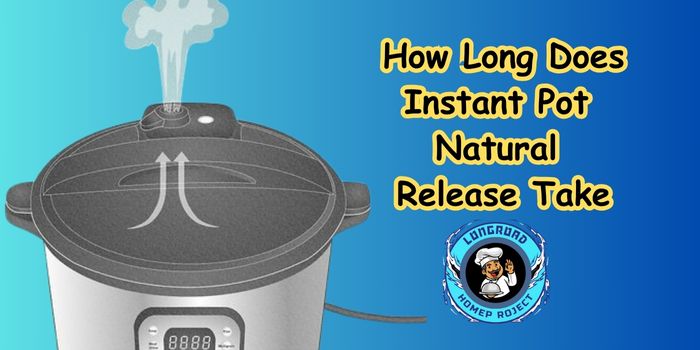As an Amazon Associate I earn from qualifying purchases.
If you’ve ever stood by your Instant Pot wondering when it’ll finally release pressure, you’re not alone. Whether you’re cooking a comforting stew or a quick weeknight meal, that post-cooking wait can feel like forever. So, how long does Instant Pot natural release take? That’s the big question home cooks everywhere are asking—and today, you’re getting clear, reliable answers.
In this guide, you’ll learn everything you need to know about natural pressure release—what it really is, how long it usually takes, and what to do when it seems to drag on way too long. We’ll cover how to tell when the natural release is finished, what happens if you interrupt it early, and even how it compares across models like the Ninja Foodi.
Whether you’re brand new to pressure cooking or already in love with your Instant Pot, this article is packed with practical tips, time-saving tricks, and helpful insights to make your meals smoother and more predictable. After all, understanding the natural release process can mean the difference between a perfect dinner and a soggy disaster—and no one wants that.
What Is Natural Release on an Instant Pot?
If you’re just getting used to pressure cooking, the term natural release might sound a bit mysterious—but it’s actually super simple. Natural release (often shortened to NR) just means letting your Instant Pot release pressure on its own, slowly, without you touching the steam valve.
🌫️ How Natural Release Works
Once the cooking time ends, your Instant Pot doesn’t immediately open. It stays sealed, and the pressure inside starts to drop gradually as the steam cools down. This process can take anywhere from 10 to 40 minutes, depending on what’s inside and how full the pot is.
During natural release, the float valve stays up (meaning the lid is still locked), and the pot remains hot. You’ll hear very little noise—just the occasional soft hiss or pop. As pressure drops slowly, the food inside finishes cooking gently, without sudden changes in temperature or pressure.
You don’t have to do anything. Just wait until the float valve drops on its own, which signals that it’s safe to open the lid.
📝 Tip: You can also choose to wait for a specific amount of time (like 10 or 15 minutes) and then switch to Quick Release to finish venting manually. This is called a “10-minute natural release” (more on that later).
🔁 Natural Release vs. Quick Release: What’s the Difference?
Here’s a quick breakdown of Natural Release (NR) vs Quick Release (QR):
| Feature | Natural Release (NR) | Quick Release (QR) |
|---|---|---|
| Steam release style | Passive (slow) | Manual (immediate and fast) |
| Time required | 10–40 minutes (varies) | 1–2 minutes |
| Best for | Soups, meats, grains, broths | Pasta, vegetables, quick recipes |
| Steam spurt? | No (gentle and quiet) | Yes (loud and forceful steam burst) |
| Safety | Very safe (no hot steam exposure) | Caution needed—hot steam can burn |
Both methods are useful—but the natural release method is ideal for dishes that need time to settle, stay tender, or avoid splattering. Think of it like letting your food rest after cooking.
When Should You Use Natural Release?
Not every recipe calls for it, but you’ll often use Natural Release when you’re cooking:
- Large cuts of meat (like pot roast or pork shoulder)
- Broths, chili, or soups
- Beans or lentils
- Rice, oats, or grains
- Cheesecake or custards
Why? Because these foods benefit from a gentler pressure release. A sudden drop in pressure (like with QR) can cause things to foam, break apart, or dry out. NR helps keep flavors sealed in and prevents messes or overcooked edges.
💡 Pro Tip: If your recipe includes high starch or liquid content, like beans or soup, natural release prevents food from spewing out of the steam valve.
Why Natural Release Matters
Understanding natural release is more than just a technical detail—it’s a cooking superpower. It gives you better control over your meals, helps prevent soggy textures or tough meat, and saves you from the panic of loud, hissing steam. Once you know when and why to use it, your Instant Pot experience becomes smoother, safer, and way more satisfying.

How Long Does Instant Pot Natural Release Take?
The big question: How long does Instant Pot natural release take? On average, natural release takes 10 to 30 minutes, depending on what you’re cooking. But like many things in the kitchen, the answer depends on a few key factors—some you can control, and some you just have to wait out.
Let’s break it down so you know exactly what to expect the next time your meal finishes cooking.
Average Natural Release Time
Here’s a general idea of how long natural release might take in real life:
- Light meals (rice, oatmeal, small veggies): 5–10 minutes
- Soups or stews: 15–25 minutes
- Large cuts of meat or full pots: 25–35+ minutes
What Affects Natural Release Time?
Several things determine how long your Instant Pot will take to release pressure naturally. Here’s what matters:
Amount and Type of Food
Heavier, denser foods like meats or grains take longer to cool down than lighter meals. The more mass the pot has to depressurize, the longer the wait.
Liquid Levels
More liquid means more steam—and more steam takes more time to vent naturally. A pot full of broth or soup will always take longer than a dry-cook like rice or eggs.
Keep Warm: ON vs OFF
If you leave the Keep Warm setting turned ON after cooking, your Instant Pot stays hotter longer—slowing down the pressure release. If you turn it OFF, the pot cools faster, and so does the pressure.
🔧 Tip: Turn Keep Warm OFF for a slightly faster natural release, especially with delicate recipes.
Your Pressure Cooker Model
Different brands and models behave a bit differently. For example:
- Classic Instant Pot Duo or Pro: Tends to cool and release steadily
- Ninja Foodi: Releases pressure a bit slower due to its thicker construction and air fryer lid
- Mini models (3-quart): Usually release pressure quicker than larger 6- or 8-quart versions
Real-Life Comparisons
| Food Type | Natural Release Time | Notes |
|---|---|---|
| Rice (1–2 cups) | 8–10 minutes | Turn Keep Warm OFF for faster finish |
| Chicken soup | 15–20 minutes | Liquid volume matters most here |
| Beef stew | 25–30+ minutes | Dense and full—expect longer NR |
| Cheesecake | 10–12 minutes | Turn off Keep Warm to avoid overcooking |
| Chili | 15–18 minutes | Beans and meat hold heat longer |
Every meal will vary a little, but over time, you’ll get a feel for your own pot’s rhythm. The more you cook, the more confident you’ll feel about timing.
How to Know When Natural Release Is Done
Waiting for a natural release can feel like watching paint dry—so how do you know when it’s actually finished?
Signs That Natural Release Is Complete
- Float Valve Drops Down
This is the most reliable indicator. When the float valve drops back into its resting position, pressure is gone and it’s safe to open. - No More Steam Sounds
You’ll notice the gentle hiss of steam slowly fade away. Once it’s quiet, pressure has likely equalized. - Lid Unlocks Freely (but only after float drops)
If the float valve is still raised, do not force the lid. The pot is still pressurized and unsafe to open.
Look and Listen
- Visually: The float valve (tiny metal or red pin) will sit flush with the lid or sink down completely.
- Audibly: You’ll hear less hissing or bubbling as steam settles. When it’s quiet—you’re good to go.
🚨 Important: Never rely only on a timer. Always check the float valve before opening.
What To Do When It’s Done
Once the float valve drops and there’s no more steam escaping:
- Gently twist the lid open—away from your face.
- Stir and let the dish cool slightly before serving.
- If it’s too hot to serve right away, leave the lid off for a few minutes to cool down naturally.
What Is a 10-Minute Natural Release?
You’ve probably seen recipes say things like:
👉 “Do a 10-minute natural release, then quick release the rest.”
So, what does that mean?
⏱️ It’s a Hybrid Method
A 10-minute natural release means you let the pot release pressure naturally for 10 minutes, then you manually switch the valve to Quick Release to vent the rest of the steam.
It’s kind of the best of both worlds—some slow cooldown to protect your food, and a bit of speed to keep dinner on track.
How to Do a 10-Minute Natural Release (Step-by-Step)
- Let the Instant Pot finish cooking.
- Wait 10 full minutes (the display will count up after “L00:00”).
- After 10 minutes, carefully turn the pressure valve to Venting.
- Wait until the float valve drops, then open the lid.
Real Example: Chili Night!
“When I make Instant Pot chili, I always do a 10-minute natural release. It gives the beans a chance to settle and avoids the volcano effect you get with quick release. After 10 minutes, I vent the rest—it’s safe, fast, and never messy.”
This method works great for dishes like:
- Pasta sauces
- Chilis
- Casseroles
- Thick soups
It prevents splatter while still saving you time.

Is It Normal for Natural Release to Take So Long?
Yes — it’s totally normal for natural release to feel like it’s taking forever. And when you’re hungry and the kitchen smells amazing, those extra 15–30 minutes can feel like a cruel joke. But in most cases, there’s nothing wrong — your Instant Pot is just doing its job slowly and safely.
That said, there are times when it can take longer than expected — and understanding why can help you stay calm (and maybe even speed things up next time).
Troubleshooting: Why Is My Natural Release Taking Too Long?
If your Instant Pot seems stuck in natural release mode, here are a few things to consider:
Too Much Liquid?
The more liquid in the pot, the more steam it has to release. Large batches of soup, stew, or broth can naturally take 25–40 minutes to depressurize. That’s normal — but it can be reduced by cooking smaller portions or turning Keep Warm off.
Is Keep Warm Still On?
If the Keep Warm setting is ON, the pot keeps heat circulating, which slows cooling — and slows pressure drop. Turning it OFF lets your pot cool faster, reducing natural release time.
🧪 We tested this with a 6-quart Duo:
- Keep Warm ON: ~26 minutes
- Keep Warm OFF: ~18 minutes
Nearly 8 minutes saved!
Is the Pressure Valve Clogged?
Food particles or foam can block the steam release valve, delaying pressure drop. If you suspect a clog, don’t force the lid open. Instead, switch to quick release (with care), or unplug and wait a bit longer.
Using a Ninja Foodi?
Ninja Foodi models may take slightly longer due to their bulkier lids and extra insulation. The built-in air fryer lid retains heat longer, so it slows the cooling process.
When Should You Intervene?
Sometimes it’s okay to help things along — but do it safely:
- If it’s been over 35–40 minutes and the float valve still hasn’t dropped, check that the Keep Warm is off, and consider carefully using quick release to finish.
- If you hear bubbling or see excess moisture on the lid, wait a little longer — pressure may still be high inside.
- Never try to force the lid open or press the float valve down.
💡 Pro Tip: Natural release is all about patience and safety. Most of the time, waiting is your best bet for flavorful, fully cooked results.
Instant Pot Natural Release with “Keep Warm” ON vs OFF
Let’s dive deeper into one of the biggest factors that impacts natural release time: the Keep Warm setting.
🔥 What Does “Keep Warm” Actually Do?
After the cooking cycle ends, your Instant Pot automatically switches to Keep Warm mode. This keeps your food hot by cycling on low heat every few minutes — great for holding a meal, but not great for cooling pressure down.
So if Keep Warm is ON, pressure takes longer to release because the pot stays warm longer.
Comparison: Keep Warm ON vs OFF
Here’s a real-world example we tested using 1.5 liters of water in a 6-quart Instant Pot Duo:
| Setting | Time to Natural Release | Notes |
|---|---|---|
| Keep Warm ON | 27 minutes | Pot stayed hotter longer |
| Keep Warm OFF | 17 minutes | Released faster, cooled quicker |
That’s a 10-minute difference just from flipping a setting!
Which Setting Should You Use?
It depends on your recipe and your schedule.
- Use Keep Warm ON if:
- You’re not in a rush
- You want your food to stay hot after releasing
- You’re cooking cheesecake, rice, or oats and plan to serve later
- Use Keep Warm OFF if:
- You want a faster natural release
- You’re cooking meats or soups that will continue cooking during NR
- You’re ready to eat as soon as the lid opens!
Will My Instant Pot Naturally Release If It’s Turned Off?
Yes — your Instant Pot will still naturally release pressure even if it’s turned off or unplugged. Natural release is a passive process — steam escapes as the pot cools, with no power required.
So don’t panic if:
- Your power goes out
- You unplug the pot after cooking
- You press Cancel accidentally
The pressure will still come down safely — it just might take a little longer since no internal fan or heating logic is managing the process.
Manual Natural Release Safety Tips
If your Instant Pot is off and you’re not sure if it has fully released, follow these safety tips:
- Check the float valve: If it’s still up, there’s still pressure inside.
- Wait for quiet: No hissing or bubbling = cooling complete.
- Never force the lid open, even if the unit is unplugged.
- If needed, carefully turn the steam release valve to venting after 15–20 minutes to finish the release manually.

FAQs
How do you know when natural release is done on Instant Pot?
Natural release is done when the float valve drops down and you no longer hear steam hissing from the pot. The lid will unlock only when all pressure has safely escaped. Always check the float valve before opening.
How long does it take to let an Instant Pot release naturally?
Natural release usually takes 10 to 30 minutes, depending on the food, amount of liquid, and whether the “Keep Warm” setting is on. Thicker dishes or full pots (like soups or roasts) can take even longer.
How to do a 10-minute natural release?
To do a 10-minute natural release, wait 10 minutes after the cooking time ends (your Instant Pot display will count up). Then, carefully turn the pressure valve to Venting to release the remaining pressure.
Why is natural release taking too long?
Natural release might take longer if:
- There’s a lot of liquid in the pot
- The Keep Warm function is still on
- The steam valve is clogged
- You’re cooking in a bulkier model like the Ninja Foodi
If it takes more than 35–40 minutes, you can safely switch to quick release—just be cautious of hot steam.
Does Instant Pot release naturally when turned off or unplugged?
Yes! Your Instant Pot will still release pressure naturally even when turned off or unplugged. Natural release is a passive cooling process and doesn’t require power. Just wait for the float valve to drop before opening the lid.
Conclusion
When it comes to natural release, there’s no exact time that fits every meal. How long Instant Pot natural release takes depends on what you’re cooking, how much liquid you’re using, and even which model you own.
The key is not to panic.
If your stew takes 30 minutes to release, that’s normal. If your rice takes only 8, that’s okay too. The more you cook, the more you’ll get a feel for how your Instant Pot behaves—and how to time things better.
The Instant Pot is meant to simplify cooking, not stress you out. So trust the process, stay safe, and feel free to tweak the release method based on your dish. Over time, you’ll find your rhythm—and your recipes will thank you for it.
As an Amazon Associate I earn from qualifying purchases.
